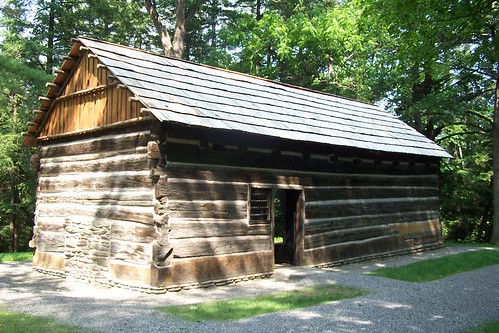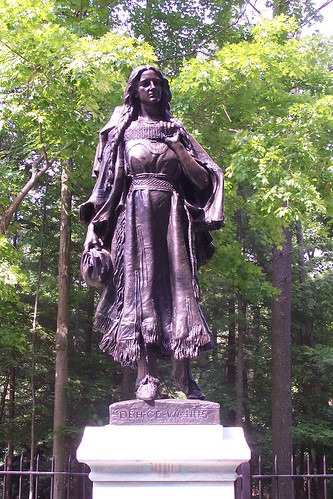 |
| By James E. Seaver [Public domain], via Wikimedia Commons |
At this time the French and Indian War continued as Mary Jemison and her family felt the effects of the war. On April 5th, 1755, French soldiers and Shawnee Indians (six Shawnee, four French) raided her family's cabin. Mary was said to be 13 at this time. They took the whole family hostage, except for her two brothers. Her brothers had escaped before they were captured. The family was taken west, to the French-built Fort Duquesne, near modern-day downtown Pittsburgh. Before arriving at the fort though, their captors made a decision to get rid of some of them. So they separated Mary and a neighbor boy (named Davy Wheelock) from the rest of their families. Mary and Davy's family members were left behind, with some of the Shawnee and French, and were killed.
Mary's mother's maiden name was Irwin before she met Thomas Jemison. (source)
 |
| By Sébastien Paquin (moi-même) [CC BY-SA 3.0], via Wikimedia Commons |
Once the summer of 1762 arrived, Mary and Sheninjee, with Thomas in a cradleboard on her back, set off with a small party towards New York State. The relocation was a nearly seven hundred mile trip to Sheninjee's homeland. They headed to an area along the Genesee River in a valley known as Sehgahunda. The name which means 'Vale of the Three Falls', describing the three waterfalls of Letchworth. Before arriving though, Sheninjee made a decision to go on a short hunt but ended up getting ill and dying. So Mary (Dehgewanus), continued on her own towards Sehgahunda, arriving as a widow in this area she didn't know well at the time. Members of Sheninjee's tribe aided her in settling near Little Beard's Town. A town which was located near present-day Cuylerville, NY. There she grieved for about a year over the loss of Sheninjee. This, her new home, inside the land of the Seneca, made for a quiet and peaceful life for a few years.
That is until the Revolutionary War broke out.
Many of the tribes had sided with the British during the Revolutionary War. Due to this, they became entangled in a battle with the Continental Army. In 1779, George Washington sent around five thousand soldiers to Little Beard's Town to battle the Seneca. The Seneca, who ambushed the soldiers in an attempt to stop them, had successes early on. Yet it wasn't enough and the Continental Army broke through their defense. They proceeded to burn down their fields and homes throughout a vast area of the Genesee River Valley. As John Sullivan's troops arrived at Little Beard's Town, the Seneca retreated to the forest. While other members of the tribe fled to other Seneca villages that hadn't been attacked. Dehgewanus went south from Little Beard's Town and to an abandoned village known as Gadaho. She and her children found shelter there with two runaway slaves.
As time went on, she adapted even more to the culture of the Seneca and lived completely as one of them. It was, in living along the Genesee River, where she met Hiokatoo and they spent years living there until the land was bought up by land speculators. This came after the Seneca tribe voted, likely pressured into a vote at Big Tree (present-day Geneseo) in the summer of 1797. They were persuaded to sell their land to said speculators. The treaty upset a lot of Seneca. Yet, the tribe members went along anyway and sold a good portion of their homelands to settlers. One of the lands sold was where Dehgewanus, Hiokatoo and her children lived. She was present at Big Tree and was able to get some of her land set aside to become part of the nearly eighteen thousand acre Gardeau Reservation. Even though Dehgewanus and her family still had a good amount of land to grow their food on, her family, along with the rest of the Seneca tribe, began to face more hardships. This only increased as more settlers moved into the surrounding areas. Which, in turn, the tensions began to affect her family directly. Her husband Hiokatoo died in 1811, and three of her sons were killed between 1811 and 1817. Some of the residents in the area also tried to take Dehgewanus' lands during this period.
 |
| Mary Jemison Cabin By J. Stephen Conn |
Most of her neighbors respected her, especially as she got older and was starting to be seen as an 'elder'. This is when she got the name, "Old White Woman of the Genesee." Dehgewanus was charitable and took care of those in need who showed up at her cabin. She would even visit the cabins of her neighbors, giving them tea and cake. This is around the same time when local residents convinced a doctor, James Seaver, to interview her in November 1823. At the time of the interview, which happened at Whaley Tavern, she was 80 years old. These interviews, which led to the writing of the book, as initially titled, "The Life and Times of Mrs. Mary Jemison" and its publication the following year by James Everett Seaver (Find A Grave). In 1823, the Senecas gave up (under pressure) the Gardeau Reservation and two acres of land were set aside for Dehgewanus. In 1831, she sold these lands, (yet again, another questionable sale done under pressure), and relocated to the Buffalo Creek Reservation, where she died on September 19, 1833, age 89 or 90.
About forty years after her death, her grave was relocated to Letchworth from the Buffalo Creek Reservation. This came after the sale of the reservation and after her grandchildren petitioned William Pryor Letchworth to relocate her grave to the park. He agreed to do so and in March of 1874, Dehgewanus' remains were placed in a new walnut coffin and brought to the Genesee River Valley by train. At the ceremony on the Council Ground, mixing both Seneca and Christian observances, she was buried on a bluff above Letchworth's Middle Falls. The site is marked by a statue of her carrying Thomas in a cradleboard on her back.
 |
| White Woman of the Genesee By J. Stephen Conn |
Videos about Mary Jemison
Links
- Find A Grave - Mary Jemison
- Historical sketches of Western New York
- Centennial History of the Town of Nunda: With a Preliminary Recital of the ... - Google Books
- Mary Jemison Historical Marker
- Mary Jemison, Captivity Narrative from the 1750s (1824)
- MARY JEMISON CHILDREN - Jemison - Family History & Genealogy Message Board - Ancestry.com
- Mary Jemison's Time line
- ~ ~ Story of Mary Jemison ~ ~
- Jemison family
- Explore PA History - Mary Jemison
- Camp Martin Travels : The Abduction of Mary Jemison
- Our Letchworth History Photo Album
- People, Places, and Things in Letchworth Park History
- Mary Jemison, the Irishwoman who turned Native American
- Mary Jemison by Jane Marsh Parker (Mary's timeline is a little different in this)


